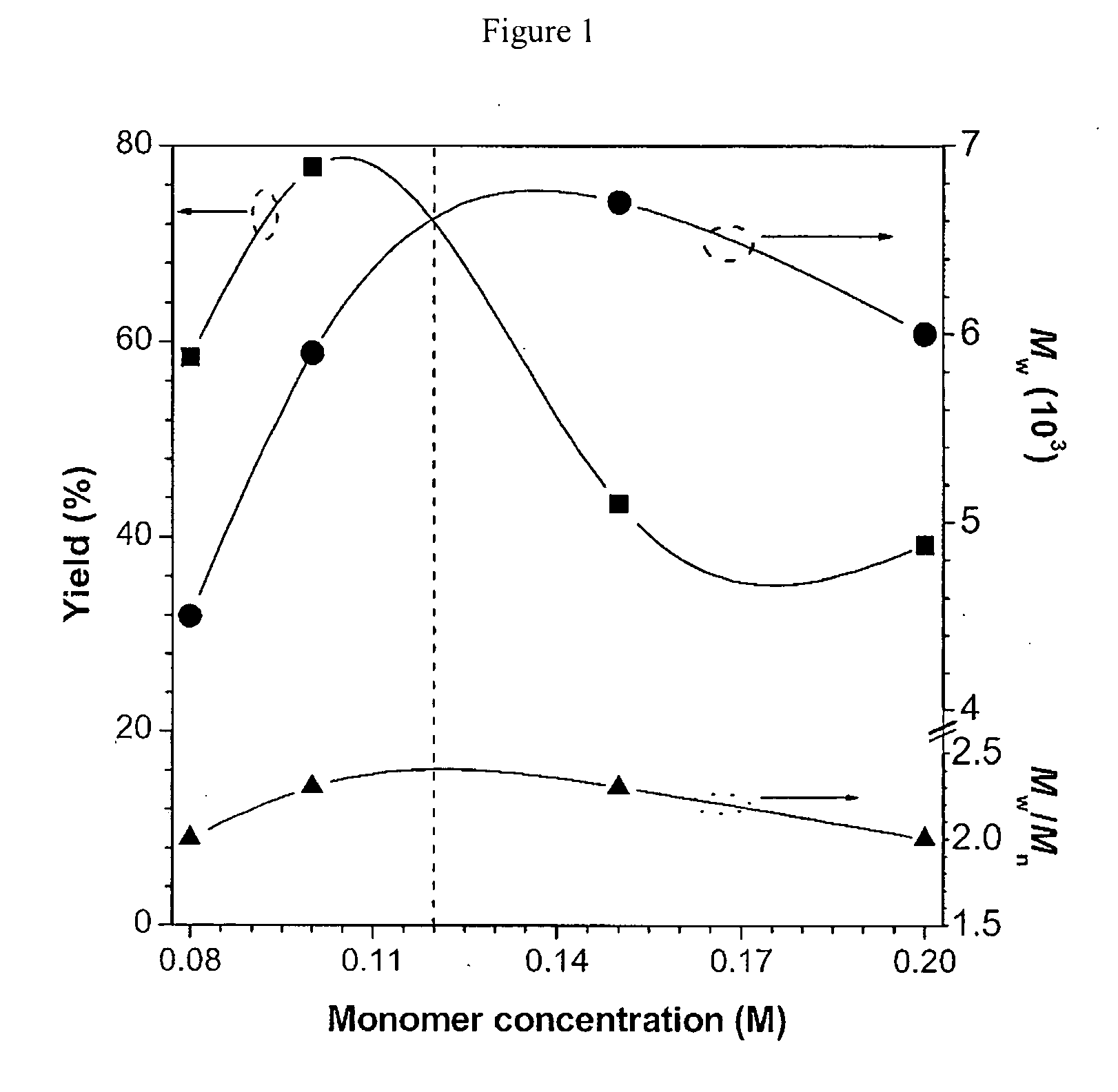Polytriazoles constructed by 1, 3-dipolar cycloaddition
a polytriazole and cycloaddition technology, applied in the direction of organic chemistry, steroids, etc., can solve the problems of limited practical applicability, limited practical application, and inability to investigate the resultant materials and their practical applications, and achieve the only possibility of soluble hyperbranched polymers
- Summary
- Abstract
- Description
- Claims
- Application Information
AI Technical Summary
Problems solved by technology
Method used
Image
Examples
example 1
Hyperbranched polytriazole constructed from tris(4-ethynylphenyl)amine and 1,4-bis(4-azidobutoxy)benzene (PI)
[0071]
[0072]Into a 20 mL Schlenk tube with a stopcock in the sidearm were added tris(4-ethynylphenyl)amine (0.126 g, 0.4 mmol) and 1,4-bis(4-azidobutoxy)benzene (0.183 g, 0.6 mmol). The tube was evacuated and refilled with nitrogen three times through the side arm. Then freshly distilled 1,4-dioxane (3.5 mL) was injected. The mixture was refluxed for 72 h. After cooled down to room temperature, the solution was diluted with small amount of chloroform and then added dropwise to 300 mL hexane / chloroform mixture (10:1, v / v) through a cotton filter under stirring. The precipitation was collected and dried to constant weight in vacuum.
[0073]Characterization data: Yellow powder; yield: 64.0%. Mw 5500; Mw / Mn 2.0 (GPC, polystyrene calibration). 1,4-disubstituted 1,2,3-triazole content (53%). IR (KBr), ν (cm−1): 3283, 2097, 1606, 1557, 1506, 1227, 825. 1H NMR (300 MHz, DMSO-d6), δ (pp...
example 2
Hyperbranched polytriazole by 1,3-dipolar cycloaddition of tris(4-ethynylphenyl)amine and 1,4-Bis(6-azidohexyloxy)benzene (PII)
[0074]
This hyperbranched polytriazole was carried out in accordance with the same procedure as described in Example 1 with tris(4-ethynylphenyl)amine (0.126 g, 0.4 mmol) and 1,4-bis(4-azidobutoxy)benzene (0.216 g, 0.6 mmol).
[0075]Characterization data: Yellow powder; yield: 75.7%. Mw 11400; Mw / Mn 2.7 (GPC, polystyrene calibration). 1,4-disubstituted 1,2,3-triazole content (50%). IR (KBr), ν (cm−1): 3286, 2095, 1601, 1556, 1506, 1491, 1228, 824. 1H NMR (300 MHz, DMSO-d6), δ (ppm): 8.60, 7.89, 7.51, 7.23, 7.09, 6.86, 4.47, 4.21, 3.88, 1.95, 1.83, 1.72, 1.63, 1.45, 1.39, 1.32. 13C NMR (75 MHz, DMSO-d6), δ (ppm): 152.5, 147.4, 146.7, 146.0, 136.7, 132.7, 132.3, 129.2, 126.5, 126.4, 125.0, 124.5, 124.3, 123.8, 123.2, 123.0, 122.8, 118.6, 115.0, 82.9, 67.8, 56.3, 50.8, 49.7, 47.6, 29.7, 29.4, 28.6, 28.5, 28.2, 25.9, 25.7, 25.1, 24.9. Elem. Anal.: Calcd (%): C, 72....
example 3
Hyperbranched polytriazole by polymerization of 1,3,5-triethynyl-2-(hexyloxy)benzene and 1,4-bis(4-azidobutoxy)benzene (PIII)
[0076]
This hyperbranched polymer was carried out in accordance with the same procedure as described in Example 1 with 1,3,5-triethynyl-2-(hexyloxy)benzene (0.125, 0.5 mmol) and 1,4-bis(4-azidobutoxy)benzene (0.228 g, 0.75 mmol).
[0077]Characterization data: Orange power, yield: 47.9%. Mw 10600; Mw / Mn 2.7 (GPC, polystyrene calibration).
PUM
| Property | Measurement | Unit |
|---|---|---|
| reaction time | aaaaa | aaaaa |
| organic | aaaaa | aaaaa |
| volume:volume | aaaaa | aaaaa |
Abstract
Description
Claims
Application Information
 Login to View More
Login to View More - R&D
- Intellectual Property
- Life Sciences
- Materials
- Tech Scout
- Unparalleled Data Quality
- Higher Quality Content
- 60% Fewer Hallucinations
Browse by: Latest US Patents, China's latest patents, Technical Efficacy Thesaurus, Application Domain, Technology Topic, Popular Technical Reports.
© 2025 PatSnap. All rights reserved.Legal|Privacy policy|Modern Slavery Act Transparency Statement|Sitemap|About US| Contact US: help@patsnap.com



